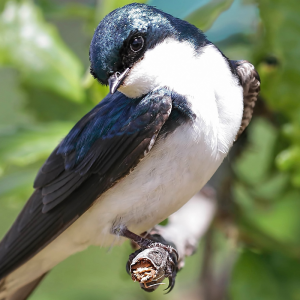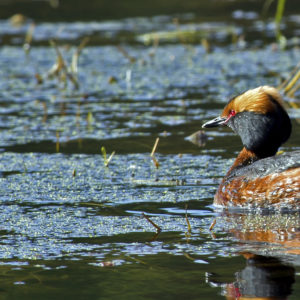Célébrez les “oiseaux du Canada”!
Canada Jay
The Gray Jay was known as the “Canada Jay” until The American Ornithologists’ Union 5thedition, published in 1957. It is also known as “Whiskey Jack”—an English variation on its Algonquin name “Wisakajack,” which refers to a forest trickster spirit found in Algonquian mythology. In French, it continues to go by the name “Mésangeai du Canada.” We love the name Mésangeai because it combines the concept of two families of birds into one – the Jays (les Geais) and the Chickadees (les Mésanges) into one bird. And the Mésangeai does not disappoint as it looks like a giant Chickadee, and it seems to capture the curious or trusting nature, storing habits, survival skills and cuteness factor of both families.
In 2016, Canadian Geographic’s “National Bird Project” picked the Gray Jay as its official choice for Canada’s national bird. The aim of the project is to recommend a bird to the government in the hopes of having a national bird declared for Canada’s 150th anniversary.
- Common name: Gray Jay
- Scientific name: Perisoreus Canadensis
- Other names: Whiskey Jack, Mésangeai du Canada (French)
- Range: Throughout Canada; year-round
- Description: Gray Jays are relatively large songbirds with a short bill, a rounded head and a long tail. They are dark grey above and light grey below, and the back of their head is black.
Canada Warbler
The Canada Warbler, formerly “Canadian Warbler” in The American Ornithologists’ Union 1st and 2nd editions, is a small songbird that arrives in Canada in late May for its breeding season. In fact, eighty-five percent of the global breeding population occurs in Canada.
Currently, the Canada Warbler’s status under the Species at Risk Act (SARA) is “Threatened” and it is also designated as “Threatened” according to the 2008 assessment by the Committee on the Status of Endangered Wildlife in Canada (COSEWIC). Between 1997 and 2007, the Canada Warbler saw a 43% decline. The most likely factors in this decline are believed to be habitat loss and degradation in its wintering region. If you are portaging along a river on the Canadian shield or int the boreal forest in June, you may hear the complex song of this golden bird burst forth from the tumbled over tree roots and mossy boulders.
- Common name: Canada Warbler
- Scientific name: Cardellina canadensis
- Range: YT, NWT, BC, AB, SK, MB, ON, QC, NB, PEI, NS; in the summer
- Description: The Canada Warbler is a small, brightly coloured songbird. Males are typically more vibrant than females, blue-grey above with a yellow underbody. The Canada Warbler has a thin bill and has yellow “spectacles” around its eyes.

Canada Goose
The Canada Goose is a bird extremely common in Canada, despite being nearly driven to extinction in the early 1900s. There are 11 subspecies of Canada Goose, though the four smallest are now known distinctly as Cackling Goose.
Along with the Canada Jay, the Canada Goose made it to the top five birds in the running for Canadian Geographic’s “National Bird Project.” Canada Geese are a staple in the food supply of the Cree living around James Bay.
- Common name: Canada Goose
- Scientific name: Branta Canadensis
- Range: Throughout Canada; in the summer
- Description: The Canada Goose is a large waterbird with a signature black neck and a white chinstrap. Its back is brown and its underside is tan. It has webbed feet and a flat bill.

Have you spotted one on these birds in your neighbourhood? Let us know in the comments, or send us pictures through Facebook or Twitter!


